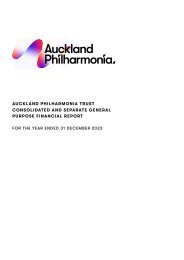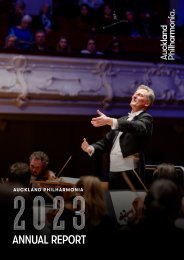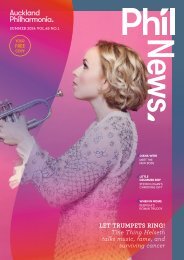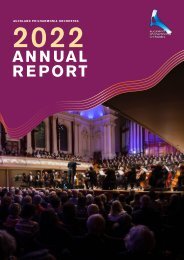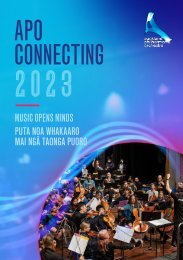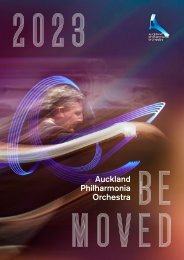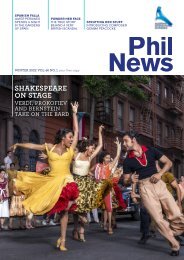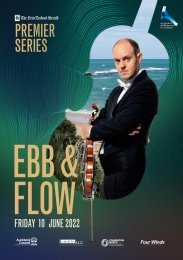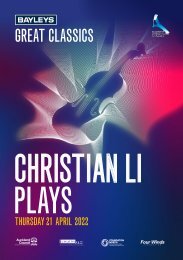Create successful ePaper yourself
Turn your PDF publications into a flip-book with our unique Google optimized e-Paper software.
apo.co.nz<br />
Wagner’s<br />
Crazy Chord<br />
Ahead of the 11 November<br />
performance of the Prelude and<br />
Liebestod from Wagner’s Tristan und<br />
Isolde, David Larsen dives deep into<br />
the chord that changed everything.<br />
Tchaikovsky walked out before the<br />
end. Alma Mahler called it the world’s<br />
only opera. Benjamin Britten said that<br />
it “dwarfs every other creation save<br />
perhaps [Beethoven’s] Ninth.” To Clara<br />
Schumann it was “the most repugnant<br />
thing I have ever seen or heard in my<br />
life,” and according to Brahms, looking<br />
at the score would put him in a vile<br />
mood for the rest of the day.<br />
Tristan und Isolde has inspired<br />
many things over the years, but not,<br />
typically, indifference. Across the broad<br />
spectrum of reactions to this story of<br />
doomed passion, the common factor<br />
would in fact be passion. This is not<br />
as easy to understand as it was once,<br />
partly because doomed passion is less<br />
scandalous than it used be, but mostly<br />
because Wagner’s score is very hard<br />
to hear as shocking now. Consider<br />
in particular the opening bars, which<br />
introduced the world to a chord that has<br />
been modestly credited with changing the<br />
course of musical history.<br />
The Tristan chord consists of F,<br />
B, D sharp, and G sharp: a dissonant<br />
interval cluster of an augmented fourth,<br />
an augmented sixth, and an augmented<br />
ninth. These notes had occurred together<br />
in several well-known works prior to<br />
Tristan and Isolde’s 1865 premiere,<br />
notably in early piano sonatas by<br />
Beethoven and Chopin. The reason we<br />
refer to the Tristan chord rather than the<br />
Beethoven Piano Sonata No.18 chord is<br />
Wagner’s approach to harmonic context<br />
and resolution, or more properly his<br />
retreat from them.<br />
There is no existing harmonic<br />
framework when we first meet the<br />
Tristan chord. Its notes could plausibly<br />
belong to multiple different keys; lengthy<br />
papers have been written over which<br />
key has the stronger implied claim. This<br />
is why the chord is commonly cited as<br />
one of the stepping stones on the way<br />
to Schoenberg: brief tonal ambiguity<br />
resembles sustained atonality the<br />
way a passing moment of dizziness<br />
resembles actual vertigo, but Wagner<br />
was the one who opened the door to the<br />
beckoning void.<br />
More startling still for its period, the<br />
chord’s hovering moment of dissonance<br />
eventually resolves into another<br />
dissonance. Roughly three hours later,<br />
seconds before the opera ends, the last<br />
of the chord’s many recurrences does<br />
resolve to a consonant harmony, so<br />
that in retrospect we can see that the<br />
pregnant pause in those opening bars<br />
has lasted for the work’s entire run time.<br />
But by then we have spent three hours<br />
in a musical landscape where a bedrock<br />
assumption of 19 th century harmony has<br />
been presented as optional. This is part of<br />
what gave Tristan und Isolde its power to<br />
shock its first audiences.<br />
The aesthetic of shimmering<br />
chromatic instability developed by later<br />
composers like Debussy owes a clear<br />
debt to the Tristan chord. The size of the<br />
debt is less clear. The most simplistic<br />
version of the story – Wagner invented<br />
musical modernism in this one work –<br />
does get told from time to time. But in<br />
fact, Debussy is only the most prominent<br />
of the 20 th century composers to explicitly<br />
quote the chord in their own work, which<br />
is one reason we struggle to hear it as<br />
abnormal now.<br />
Try to imagine what encountering<br />
these sounds at Tristan’s first<br />
performance must have been like. Like<br />
stepping outside on a fine day and finding<br />
yourself deep in the fog, maybe. Like<br />
uncertainty baring its teeth.<br />
The New Zealand Herald<br />
Premier Series<br />
Mahler 5<br />
7.30pm, Saturday 11 November<br />
Auckland Town Hall<br />
Conductor Giordano Bellincampi<br />
Wagner Rienzi Overture<br />
Wagner Tristan und Isolde: Prelude<br />
and Liebestod<br />
Mahler Symphony No.5<br />
apo.co.nz/mahler5<br />
17



